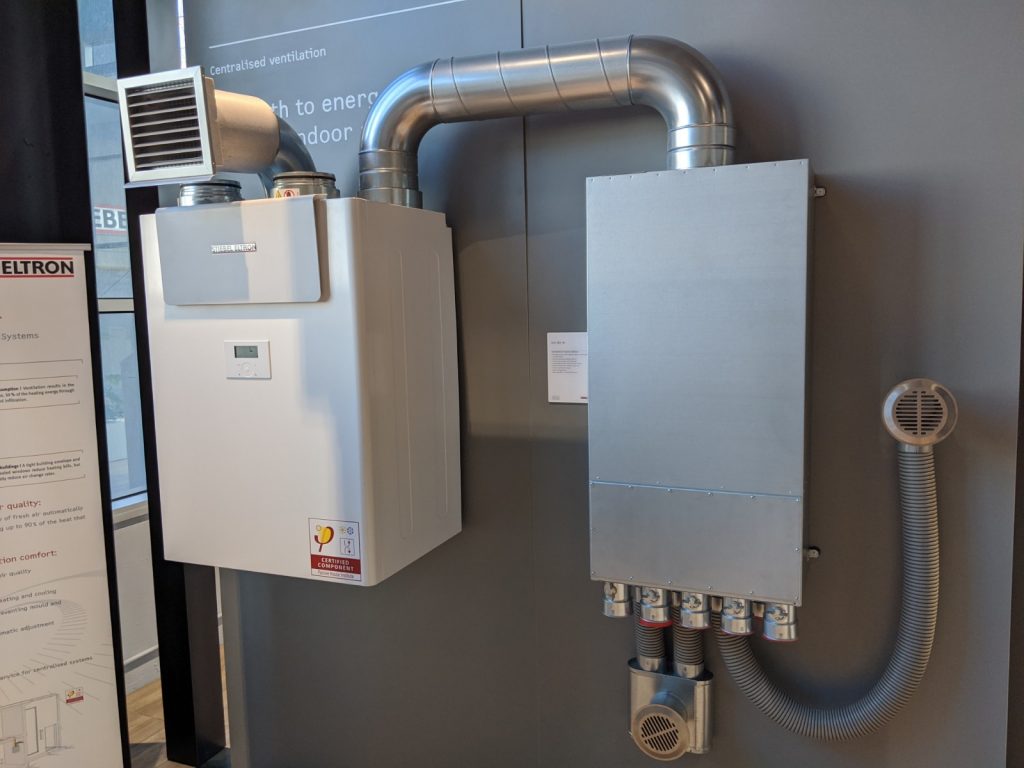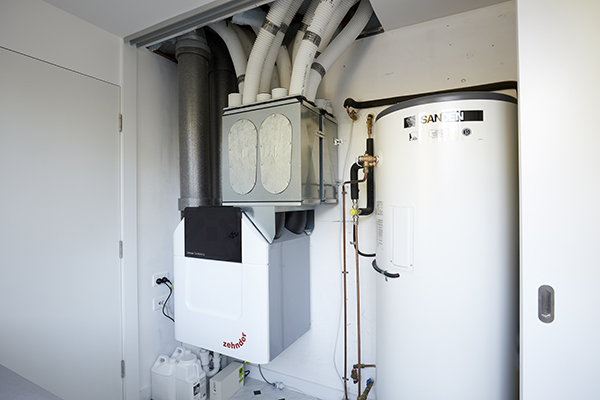Revealing the Secret Advantages and Uses of Heat Recovery Ventilation in Lasting Style
Heat Recovery Ventilation (HRV) systems play a necessary function in lasting design. They assist in a continual exchange of stagnant interior air with fresh outside air, substantially boosting interior air top quality. HRVs contribute to power efficiency by recovering heat from worn down air, which can lower energy expenses. Recognizing the multifaceted benefits and applications of HRVs discloses their relevance in modern-day design. What various other advantages do these systems offer in the quest of sustainability?
Recognizing Heat Recovery Ventilation Systems
Heat recovery ventilation (HRV) systems are created to enhance indoor air top quality while minimizing power loss. These systems utilize a mechanical ventilation strategy to exchange stale interior air with fresh exterior air, ensuring a constant supply of tidy air. By capturing warm from the exhaust air, HRVs prerequisite inbound air, lowering the demand on home heating and cooling down systems. This process not only enhances thermal convenience yet likewise adds to power efficiency in domestic and business structures. Additionally, HRV systems help regulate humidity levels and decrease interior pollutants, advertising a much healthier living environment. Their calculated execution is crucial for attaining sustainable style objectives, as they supply a balance in between energy preservation and passenger wellness.
How HRV Equipment Work
While many might recognize with ventilation systems, comprehending how heat recovery ventilation (HRV) systems operate is crucial for valuing their advantages. HRV systems work by exchanging stale interior air with fresh exterior air while moving warm in between the 2 streams. This procedure takes place in a warmth exchanger, where heat from the outgoing air warms up the inbound air during cooler months, decreasing energy loss. Conversely, in warmer months, the system can cool down incoming air using the cooler outbound air. HRVs are furnished with followers to help with airflow and filters to get rid of particulates, making sure a continuous, well balanced air flow process. This innovative style not just boosts energy effectiveness but additionally adds to keeping a comfy indoor environment.
Enhancing Indoor Air Top Quality
Interior air high quality can significantly impact wellness and wellness, making effective air flow crucial in modern-day homes. Heat Recovery Ventilation (HRV) systems play a crucial function in maintaining interior air quality by continually exchanging stagnant interior air with fresh outdoor air. This procedure not only reduces air-borne pollutants however likewise minimizes moisture levels, which can cause mold growth and respiratory problems. HRV systems filter inbound air, eliminating allergens and particulates, thus giving a healthier living atmosphere. Furthermore, these systems aid remove odors and unpredictable natural compounds (VOCs) typically discovered in house products. By ensuring a constant circulation of clean air, HRV systems add to a total improved indoor ambience, promoting convenience and health for owners.
Energy Effectiveness and Cost Savings
Power performance stands out as a considerable benefit of Heat Recovery Ventilation (HRV) systems. By catching and recycling the warm from worn down interior air, HRVs reduce the energy needed for heating incoming fresh air, causing reduced power consumption. This performance converts right into reduced utility expenses, supplying substantial cost savings for house owners and organizations alike. Furthermore, HRV systems often get power effectiveness incentives and discounts, even more improving their financial allure. In time, the preliminary investment in HRV modern technology can lead to a beneficial return on investment through reduced energy expenses. Consequently, the integration of HRV systems not only advertises lasting layout but also gives a sensible solution for attaining lasting power cost savings and monetary benefits.
Ecological Benefits of HRV

A wide variety of environmental benefits develops from the application of Heat Recovery Ventilation (HRV) systems. By successfully moving warm from exhaust air to incoming fresh air, HRVs considerably decrease the energy required for home heating and cooling down rooms. This power effectiveness equates to lower greenhouse gas exhausts, adding to a decline in the general carbon impact of structures. Furthermore, HRV systems improve indoor air high quality by constantly distributing fresh air, thereby reducing the concentration of indoor contaminants and allergens. In addition, the decrease in energy usage aids in preserving natural deposits, making HRVs an important part of lasting design. On the whole, the environmental advantages of HRVs play an important role in advertising a healthier world and cultivating environmentally friendly structure practices.
Versatile Applications in Modern Architecture
Heat recovery ventilation (HRV) systems are significantly being integrated into both property and industrial building projects. In property setups, HRVs improve indoor air high quality while taking full advantage of power efficiency. On the other hand, in business spaces, these systems optimize air flow techniques, demonstrating their versatility in contemporary architectural applications.
Residential Projects Assimilation
While modern design progressively stresses sustainability, the assimilation of heat recovery air flow systems in residential tasks has actually become a sensible solution for improving interior air top quality and power performance. These systems effectively move warmth from exhaust air to incoming fresh air, decreasing energy loss and lowering heating or cooling down needs. In new builds and retrofits alike, warmth recovery air flow can be effortlessly included, providing homeowners with a healthier living atmosphere while reducing utility prices. Furthermore, with raising awareness of environmental influences, even more architects and contractors are acknowledging the lasting advantages of these systems. Consequently, warm recovery air flow has come to my sources be a vital element of lasting residential design, showcasing flexibility and dedication to environment-friendly practices.
Industrial Areas Optimization
As contemporary commercial spaces advance to satisfy the demands of sustainability and effectiveness, the execution of warm recovery air flow systems arises as an essential strategy for maximizing indoor environments. These systems facilitate the exchange of stale interior air with fresh outdoor air while redeeming heat energy, considerably lowering energy usage. This not just enhances comfort for residents but also assists in lowering functional costs. Functional applications can be observed in offices, retail spaces, and universities, where air top quality and temperature control are extremely important. Furthermore, incorporating heat healing air flow straightens with eco-friendly structure certifications, further advertising ecological responsibility. Eventually, taking on such systems in commercial style not just contributes to sustainability goals yet also fosters healthier, extra productive rooms for users.
Integrating HRV Into Sustainable Style Practices
Integrating heat recovery air flow (HRV) systems right into sustainable design practices offers significant advantages in power performance and interior air high quality. By making use of HRV, developers can create affordable remedies that not just minimize power intake however likewise boost the overall comfort of interior environments. This placement with sustainability objectives placements HRV as a crucial part in modern architectural methods.
Power Effectiveness Enhancement
By integrating warmth recovery ventilation (HRV) systems right into lasting layout methods, architects and contractors can significantly boost energy performance in modern-day buildings. HRV systems operate by recording warmth from outbound stale air and moving it to incoming fresh air, lessening the energy needed for home heating or cooling interior areas. This process not only minimizes dependence on typical cooling and heating systems but likewise lowers total energy consumption. On top of that, HRV systems can help preserve a regular indoor temperature level, decreasing peak energy needs. By incorporating these systems, buildings can attain considerable decreases in utility prices and carbon footprints, lining up with sustainability objectives. Eventually, HRV technology stands for a practical remedy for enhancing energy performance in the developed environment, promoting even more liable source use.
Indoor Air High Quality Renovation
Just how can heat recuperation ventilation (HRV) systems contribute to remarkable interior air quality in contemporary structures? HRV systems successfully exchange stagnant interior air with fresh outdoor air while recuperating heat, decreasing temperature level fluctuations. This process minimizes the concentration of indoor contaminants, such as unstable natural substances (VOCs), allergens, and dampness, which can degrade air top quality and effect passenger wellness. By preserving excellent moisture degrees and making sure a continuous supply of clean air, HRVs help produce a much healthier interior setting. Furthermore, these systems about his can be integrated into sustainable layout methods, promoting energy efficiency together with enhanced air quality. HRV Heat Recovery Ventilation. As a result, HRV modern technology plays a crucial function beforehand total owner convenience and health in contemporary architectural designs
Economical Design Solutions

Frequently Asked Inquiries
What Upkeep Is Required for Heat Recovery Ventilation Equipments?

Maintenance for warmth recovery air flow systems usually entails routine filter substitutes, cleansing of heat exchangers, assessment of fans and air ducts, and making sure proper drain. These jobs assist maintain performance and prolong the system's life expectancy over time.
Can HRV Systems Be Set Up in Existing Buildings?
Heat recovery ventilation systems can without a doubt be set up in existing structures. HRV Heat Recovery Ventilation. Retrofitting needs cautious planning and assessment of the structure's layout, making certain compatibility with current systems while making the most of energy effectiveness and indoor air high quality
Just How Do HRV Solution Effect Sound Levels Indoors?
HRV systems can affect indoor sound degrees by introducing noise from exterior sources with air flow. Nevertheless, top notch installations usually incorporate sound-dampening features, minimizing sound effect while providing reliable air exchange and preserving convenience inside your home.
Are There Any Type Of Drawbacks to Making Use Of HRV Equipments?
The disadvantages of making use of HRV systems consist of prospective high preliminary costs, maintenance difficulties, and the possibility of decreased indoor air top quality if filters are sporadically altered, which might result in issues with humidity levels.
Exactly how Do I Select the Right HRV System for My Requirements?
Choosing the appropriate warmth recuperation ventilation system involves reviewing certain requirements, such as developing dimension, environment, and energy performance objectives. Additionally, examining system functions, installation demands, and upkeep factors to consider is crucial for peak performance and complete satisfaction.